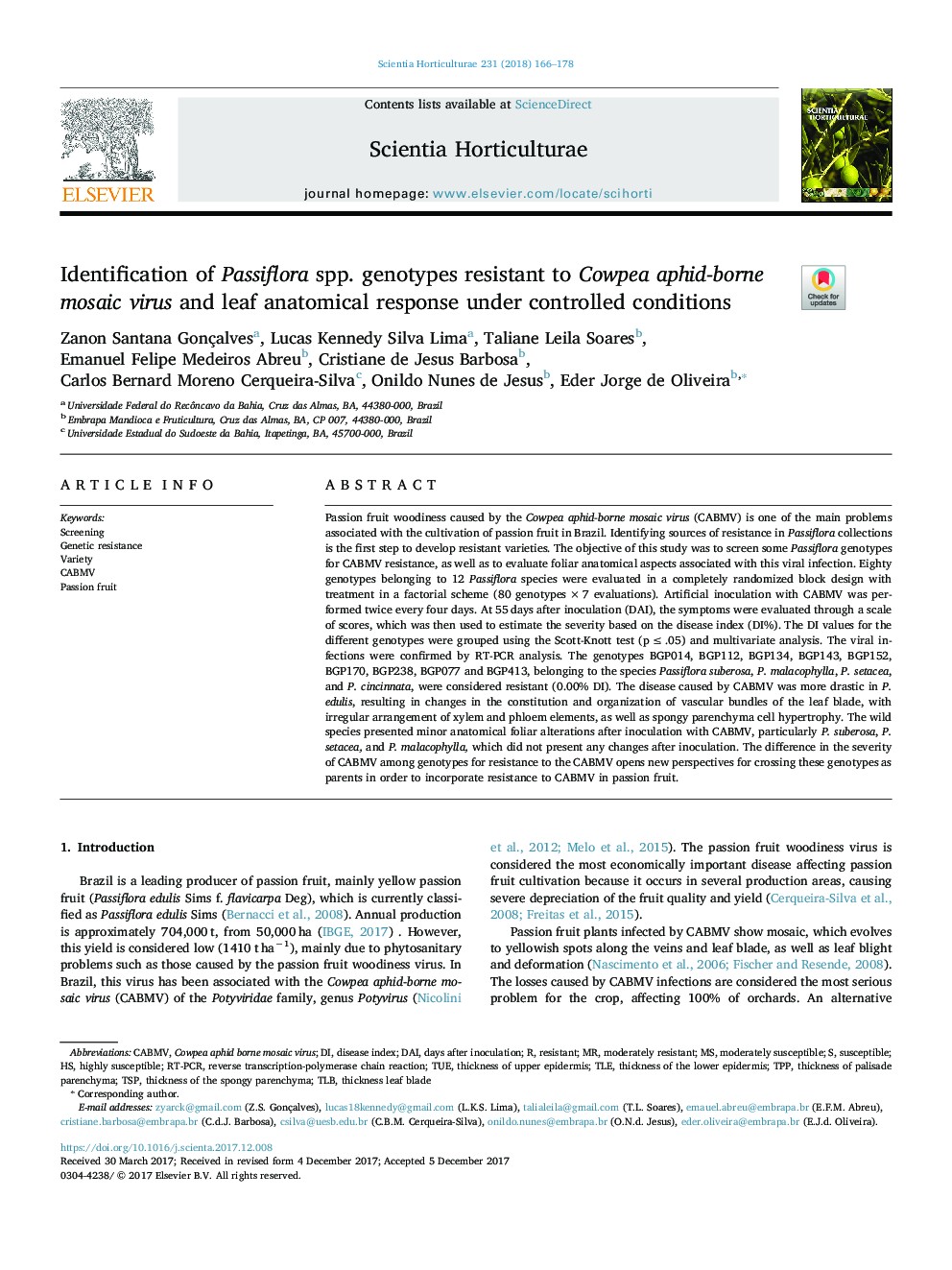| کد مقاله | کد نشریه | سال انتشار | مقاله انگلیسی | نسخه تمام متن |
|---|---|---|---|---|
| 8892986 | 1628767 | 2018 | 13 صفحه PDF | دانلود رایگان |
عنوان انگلیسی مقاله ISI
Identification of Passiflora spp. genotypes resistant to Cowpea aphid-borne mosaic virus and leaf anatomical response under controlled conditions
دانلود مقاله + سفارش ترجمه
دانلود مقاله ISI انگلیسی
رایگان برای ایرانیان
کلمات کلیدی
TPPTSPRT-PCRTLEDAITUETLBVariety - تنوعSusceptible - حساسdays after inoculation - روز بعد از تلقیحdisease index - شاخص بیماریScreening - غربالگریResistant - مقاومGenetic resistance - مقاومت ژنتیکیPassion fruit - میوه شورreverse transcription-polymerase chain reaction - واکنش زنجیره ای رونویسی-پلیمراز معکوس
موضوعات مرتبط
علوم زیستی و بیوفناوری
علوم کشاورزی و بیولوژیک
دانش باغداری
پیش نمایش صفحه اول مقاله

چکیده انگلیسی
Passion fruit woodiness caused by the Cowpea aphid-borne mosaic virus (CABMV) is one of the main problems associated with the cultivation of passion fruit in Brazil. Identifying sources of resistance in Passiflora collections is the first step to develop resistant varieties. The objective of this study was to screen some Passiflora genotypes for CABMV resistance, as well as to evaluate foliar anatomical aspects associated with this viral infection. Eighty genotypes belonging to 12 Passiflora species were evaluated in a completely randomized block design with treatment in a factorial scheme (80 genotypesâ¯Ãâ¯7 evaluations). Artificial inoculation with CABMV was performed twice every four days. At 55â¯days after inoculation (DAI), the symptoms were evaluated through a scale of scores, which was then used to estimate the severity based on the disease index (DI%). The DI values for the different genotypes were grouped using the Scott-Knott test (pâ¯â¤â¯.05) and multivariate analysis. The viral infections were confirmed by RT-PCR analysis. The genotypes BGP014, BGP112, BGP134, BGP143, BGP152, BGP170, BGP238, BGP077 and BGP413, belonging to the species Passiflora suberosa, P. malacophylla, P. setacea, and P. cincinnata, were considered resistant (0.00% DI). The disease caused by CABMV was more drastic in P. edulis, resulting in changes in the constitution and organization of vascular bundles of the leaf blade, with irregular arrangement of xylem and phloem elements, as well as spongy parenchyma cell hypertrophy. The wild species presented minor anatomical foliar alterations after inoculation with CABMV, particularly P. suberosa, P. setacea, and P. malacophylla, which did not present any changes after inoculation. The difference in the severity of CABMV among genotypes for resistance to the CABMV opens new perspectives for crossing these genotypes as parents in order to incorporate resistance to CABMV in passion fruit.
ناشر
Database: Elsevier - ScienceDirect (ساینس دایرکت)
Journal: Scientia Horticulturae - Volume 231, 27 January 2018, Pages 166-178
Journal: Scientia Horticulturae - Volume 231, 27 January 2018, Pages 166-178
نویسندگان
Zanon Santana Gonçalves, Lucas Kennedy Silva Lima, Taliane Leila Soares, Emanuel Felipe Medeiros Abreu, Cristiane de Jesus Barbosa, Carlos Bernard Moreno Cerqueira-Silva, Onildo Nunes de Jesus, Eder Jorge de Oliveira,